A Holistic Sustainability Assessment Framework for Evaluating Strategies to Prevent Nutrient Pollution
Abstract
:1. Introduction
2. Materials and Methods
2.1. Framework Formulation
2.1.1. Category and Indicator Selection
2.1.2. Indicator Quantification
2.1.3. Total Score Calculation
2.2. Framework Application
2.2.1. Application Process
2.2.2. Case Study
2.2.3. Weighting Scenario Development
3. Results and Discussion
3.1. Comprehensiveness of the Developed Framework
3.2. Robustness of Strategy Selection Using the Developed Framework
3.3. Implementation Space Informed by the Developed Framework
3.4. Flexibility of Framework Application with Limited Data
4. Conclusions
Supplementary Materials
Author Contributions
Funding
Institutional Review Board Statement
Informed Consent Statement
Data Availability Statement
Conflicts of Interest
References
- Grusak, M.A.; DellaPenna, D. Improving the nutrient composition of plants to enhance human nutrition and health. Annu. Rev. Plant Biol. 1999, 50, 133–161. [Google Scholar] [CrossRef]
- Evans, J.R.; Edwards, E. Nutrient uptake and use in plant growth. In Net Ecosystem Exchange CRC Workshop Proceedings; Cooperative Research Centre for Greenhouse Accounting: Canberra, Australia, 2001; pp. 75–81. [Google Scholar]
- Chen, Y.; Michalak, M.; Agellon, L.B. Focus: Nutrition and food science: Importance of nutrients and nutrient metabolism on human health. Yale J. Biol. Med. 2018, 91, 95. [Google Scholar]
- United Nations. SDG 14 Conserve and Sustainably Use the Oceans, Sea and Marine Resources for Sustainable Development. Available online: https://www.un.org/sustainabledevelopment/oceans/ (accessed on 13 December 2023).
- HAEDAT. Harmful Algae Event Database. Available online: http://haedat.iode.org/browseEvents.php (accessed on 5 January 2024).
- United States Environmental Protection Agency. The Effects: Human Health. Nutrient Pollution. Available online: https://www.epa.gov/nutrientpollution/effects-human-health (accessed on 18 January 2024).
- United States Environmental Protection Agency. The Effects: Economy. Nutrient Pollution. Available online: https://www.epa.gov/nutrientpollution/effects-economy (accessed on 18 January 2024).
- Wang, M.; Janssen, A.B.G.; Bazin, J.; Strokal, M.; Ma, L.; Kroeze, C. Accounting for interactions between Sustainable Development Goals is essential for water pollution control in China. Nat. Commun. 2022, 13, 730. [Google Scholar] [CrossRef]
- Rizzo, A.; Sarti, C.; Nardini, A.; Conte, G.; Masi, F.; Pistocchi, A. Nature-based solutions for nutrient pollution control in European agricultural regions: A literature review. Ecol. Eng. 2023, 186, 106772. [Google Scholar] [CrossRef]
- Xia, Y.; Zhang, M.; Tsang, D.C.; Geng, N.; Lu, D.; Zhu, L.; Igalavithana, A.D.; Dissanayake, P.D.; Rinklebe, J.; Yang, X.; et al. Recent advances in control technologies for non-point source pollution with nitrogen and phosphorous from agricultural runoff: Current practices and future prospects. Appl. Biol. Chem. 2020, 63, 8. [Google Scholar] [CrossRef]
- Fraley-McNeal, L.; Schueler, T.; Winer, R. National Pollutant Removal Performance Database; Version 3; Center for Watershed Protection: Ellicott City, MD, USA, 2007. [Google Scholar]
- Qiu, Z. Comparative assessment of stormwater and nonpoint source pollution best management practices in suburban watershed management. Water 2013, 5, 280–291. [Google Scholar] [CrossRef]
- Molinos-Senante, M.; Gómez, T.; Garrido-Baserba, M.; Caballero, R.; Sala-Garrido, R. Assessing the sustainability of small wastewater treatment systems: A composite indicator approach. Sci. Total Environ. 2014, 497, 607–617. [Google Scholar] [CrossRef]
- Afrooz, A.N.; Boehm, A.B. Effects of submerged zone, media aging, and antecedent dry period on the performance of biochar-amended biofilters in removing fecal indicators and nutrients from natural stormwater. Ecol. Eng. 2017, 102, 320–330. [Google Scholar] [CrossRef]
- Florida Department of Environmental Protection. Lake Okeechobee Basin Management Action Plan. Available online: https://publicfiles.dep.state.fl.us/DEAR/DEARweb/BMAP/NEEP_2020_Updates/Lake%20Okeechobee%20BMAP_01-31-20.pdf (accessed on 26 October 2023).
- J-Tech. C-43 West Basin Storage Reservoir Water Quality Feasibility Study—Deliverable 4.3.1 Final Feasibility Study. Available online: https://www.sfwmd.gov/sites/default/files/documents/DEL_4.3.1_C-43_Final_Feasibility_Study_all.pdf (accessed on 12 September 2023).
- Lundin, M.; Molander, S.; Morrison, G.M. A set of indicators for the assessment of temporal variations in the sustainability of sanitary systems. Water Sci. Technol. 1999, 39, 235–242. [Google Scholar] [CrossRef]
- Florida Department of Environmental Protection. Statewide Best Management Practices (BMP) Efficiencies for Crediting Projects in Basin Management Action Plans (BMAPs) and Alternative Restoration Plans. Draft-September 2021. Available online: https://publicfiles.dep.state.fl.us/DEAR/DEARweb/BMAP/BMP_Efficiencies/BMP%20efficiencies%20091621_Distribution.pdf (accessed on 12 September 2023).
- Hellström, D.; Jeppsson, U.; Kärrman, E. A framework for systems analysis of sustainable urban water management. Environ. Impact Assess. Rev. 2000, 20, 311–321. [Google Scholar] [CrossRef]
- Palme, U.; Lundin, M.; Tillman, A.M.; Molander, S. Sustainable development indicators for wastewater systems–researchers and indicator users in a co-operative case study. Resour. Conserv. Recycl. 2005, 43, 293–311. [Google Scholar] [CrossRef]
- Murray, A.; Ray, I.; Nelson, K.L. An innovative sustainability assessment for urban wastewater infrastructure and its application in Chengdu, China. J. Environ. Manag. 2009, 90, 3553–3560. [Google Scholar] [CrossRef]
- Mihelcic, J.R.; Naughton, C.C.; Verbyla, M.E.; Zhang, Q.; Schweitzer, R.W.; Oakley, S.M.; Wells, E.C.; Whiteford, L.M. The grandest challenge of all: The role of environmental engineering to achieve sustainability in the world’s developing regions. Environ. Eng. Sci. 2017, 34, 16–41. [Google Scholar] [CrossRef]
- Cornejo, P.K.; Becker, J.; Pagilla, K.; Mo, W.; Zhang, Q.; Mihelcic, J.R.; Chandran, K.; Sturm, B.; Yeh, D.; Rosso, D. Sustainability metrics for assessing water resource recovery facilities of the future. Water Environ. Res. 2019, 91, 45–53. [Google Scholar] [CrossRef]
- South Florida Water Management District. Best Management Practices for South Florida Urban Stormwater Management Systems. Available online: https://www.sfwmd.gov/sites/default/files/documents/bmp_manual.pdf (accessed on 12 September 2023).
- J-Tech. C-43 West Basin Storage Reservoir Water Quality Component-Deliverable 7.2.4 Final Water Quality Component Siting Evaluation. Available online: https://www.sfwmd.gov/sites/default/files/Final_WQ_Component_Siting_Evaluation_032621.pdf (accessed on 12 September 2023).
- Lohman, H.A.; Morgan, V.L.; Li, Y.; Zhang, X.; Rowles, L.S.; Cook, S.M.; Guest, J.S. DMsan: A Multi-Criteria Decision Analysis Framework and Package to Characterize Contextualized Sustainability of Sanitation and Resource Recovery Technologies. ACS Environ. Au 2023, 3, 179–192. [Google Scholar] [CrossRef]
- Hall, D.; Aguirre Gutierrez, M.; Cornejo, P.K. Social, Environmental, and Economic Wastewater Decision Support Tool for Small Systems. J. Environ. Manag. 2022, 148, 04022074. [Google Scholar] [CrossRef]
- Diaz-Elsayed, N.; Rezaei, N.; Guo, T.; Mohebbi, S.; Zhang, Q. Wastewater-based resource recovery technologies across scale: A review. Resour. Conserv. Recycl. 2019, 145, 94–112. [Google Scholar] [CrossRef]
- United States Department of Energy. Corporate Critical Decision (CD) Review and Approval Framework Associated with Nuclear Facility Capital and Major Construction Projects. Available online: https://www.energy.gov/sites/prod/files/Volume1_J_SRP.pdf (accessed on 12 September 2023).
- National Aeronautics and Space Administration. Technology Readiness Level Definition. Available online: https://www.nasa.gov/wp-content/uploads/2017/12/458490main_trl_definitions.pdf (accessed on 12 September 2023).
- Janssen, R. Multiobjective Decision Support for Environmental Management; Kluwer Academic Publishers: Dordrecht, The Netherlands, 1992. [Google Scholar]
- Janssen, R. On the use of multi-criteria analysis in environmental impact assessment in The Netherlands. J. Multi-Criteria Decis. Anal. 2001, 10, 101–109. [Google Scholar] [CrossRef]
- Mateo, J.R.S.C. Weighted sum method and weighted product method. In Multi Criteria Analysis in the Renewable Energy Industry, 1st ed.; Mateo, J.R.S.C., Ed.; Springer Science & Business Media: London, UK, 2012; pp. 19–22. [Google Scholar]
- Hewitt, M.; Ortmann, J.; Rei, W. Decision-based scenario clustering for decision-making under uncertainty. Ann. Oper. Res. 2022, 315, 747–771. [Google Scholar] [CrossRef]
- Cheng, M.; Frangopol, D.M. Efficient scenario analysis for optimal adaptation of bridge networks under deep uncertainties through knowledge transfer. Struct. Saf. 2023, 100, 102278. [Google Scholar] [CrossRef]
- University of South Florida. Temporal and Spatial Optimization of Existing and Emerging Nutrient Management Technologies and Practices for Control of Harmful Algal Blooms. In Proceedings of the EPA HAB Fall 2020 Stakeholder Meeting, Virtual. 21 October 2020. [Google Scholar]
- University of South Florida. Temporal and Spatial Optimization of Existing and Emerging Nutrient Management Technologies and Practices for Control of Harmful Algal Blooms. In Proceedings of the EPA HAB Spring 2022 Stakeholder Meeting, Virtual. 30 March 2022. [Google Scholar]
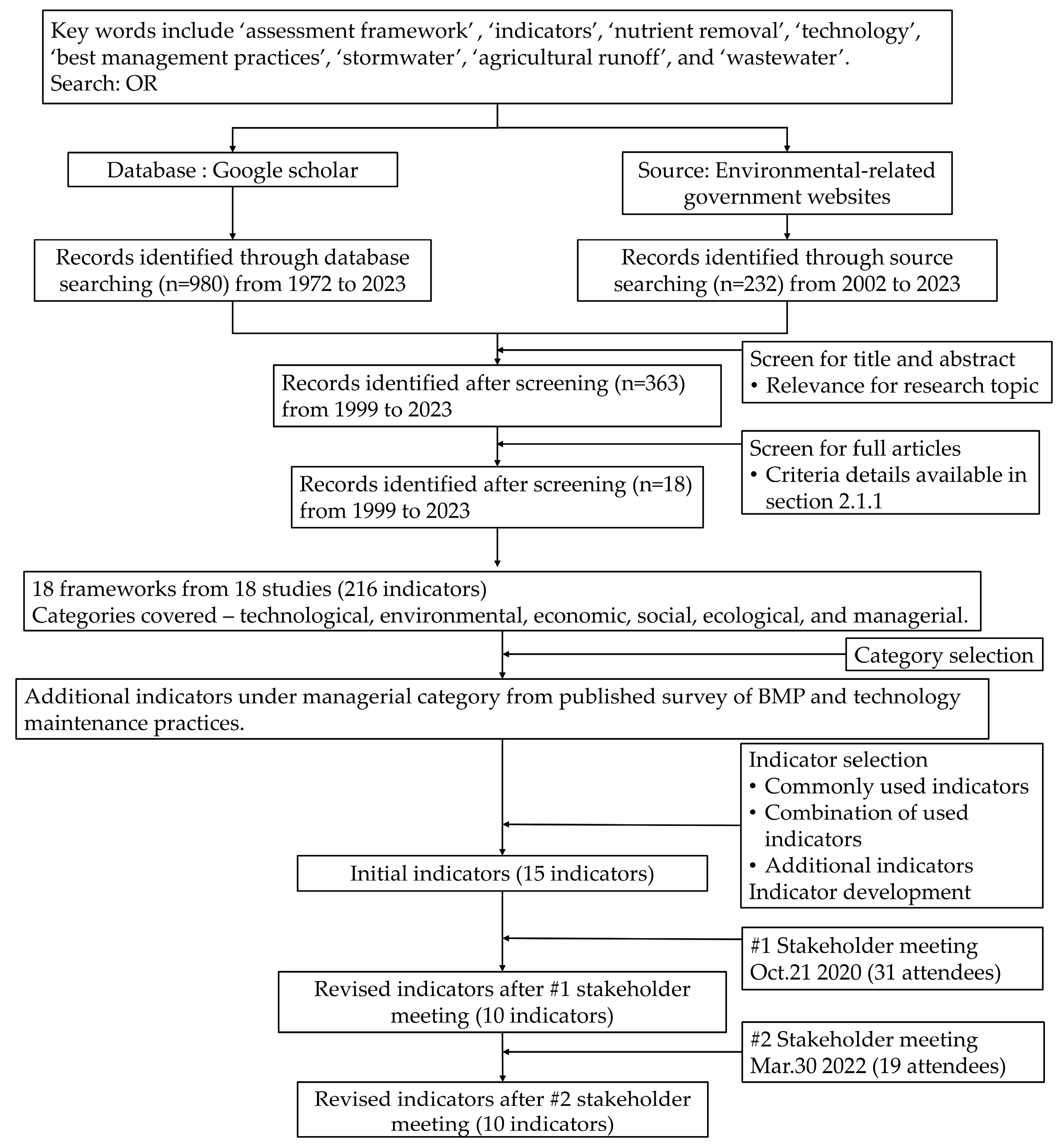

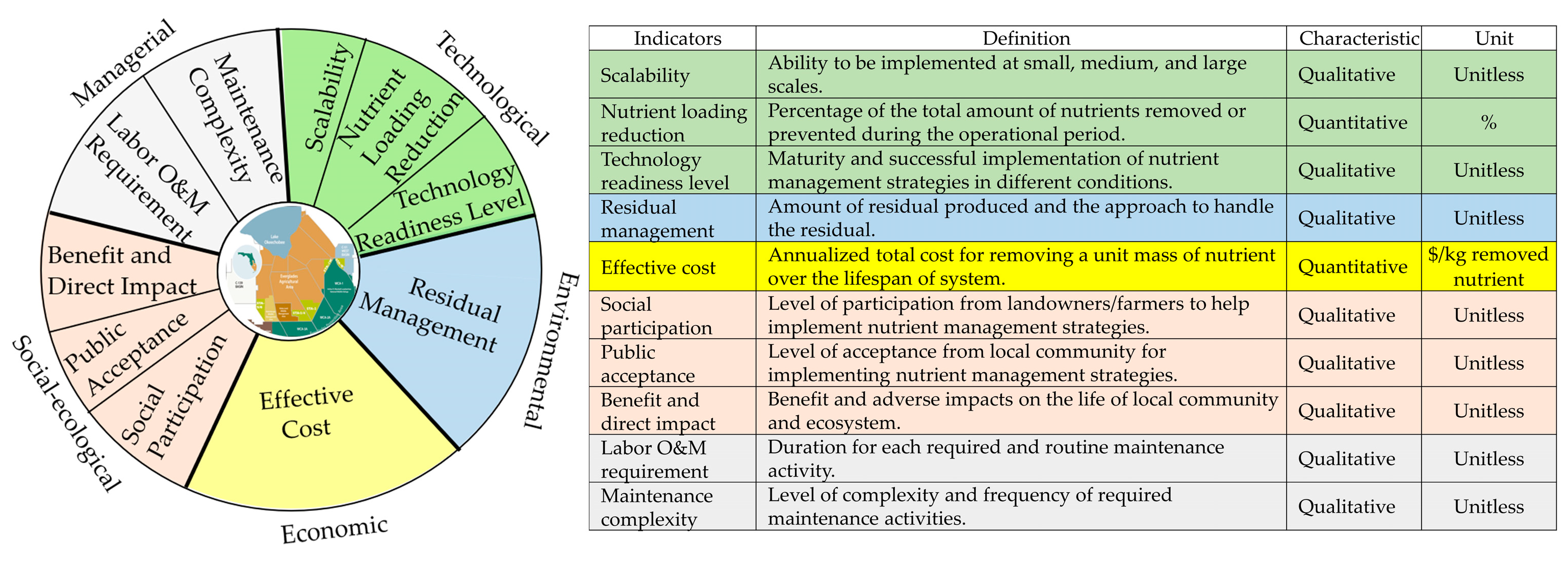
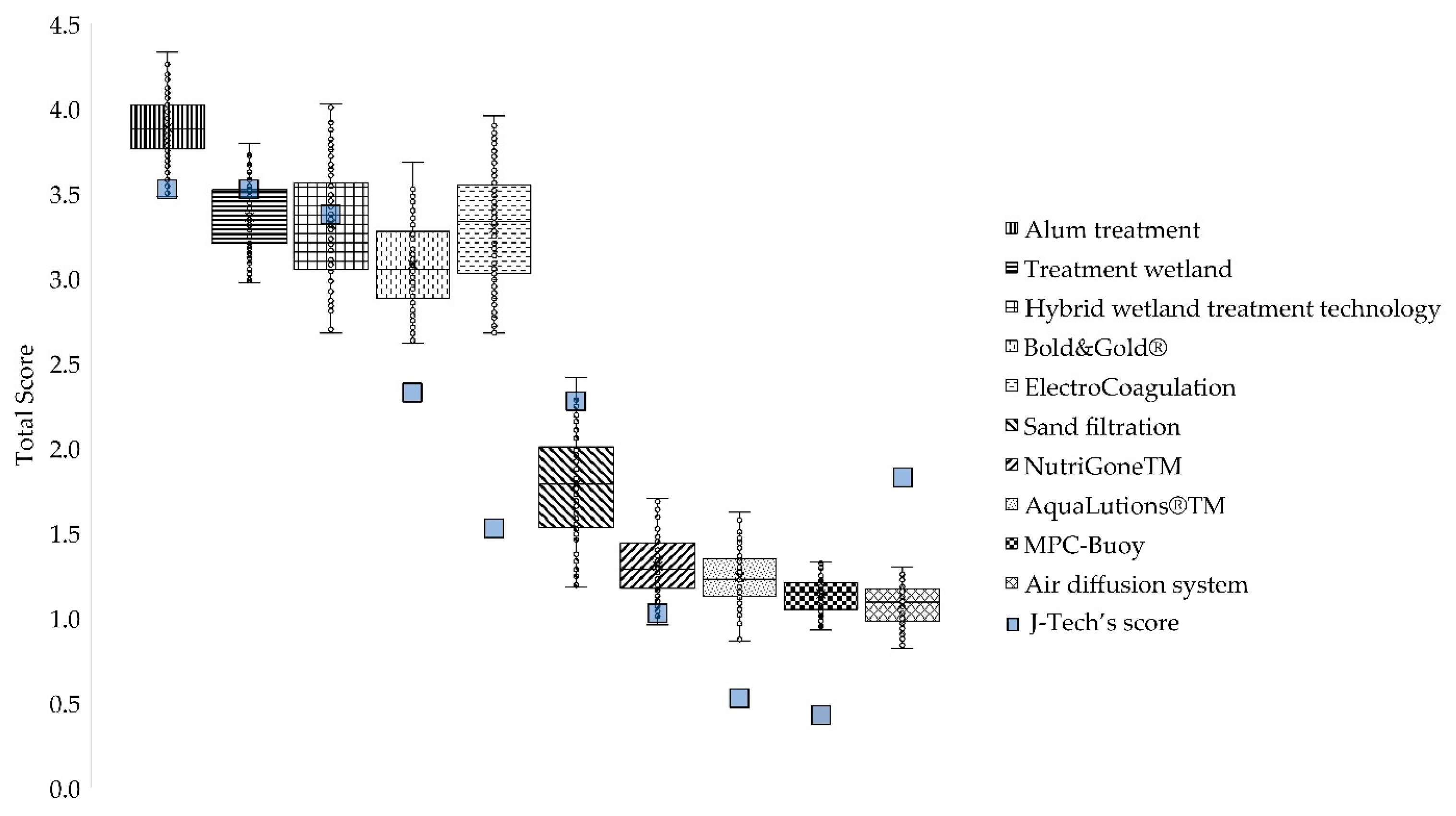
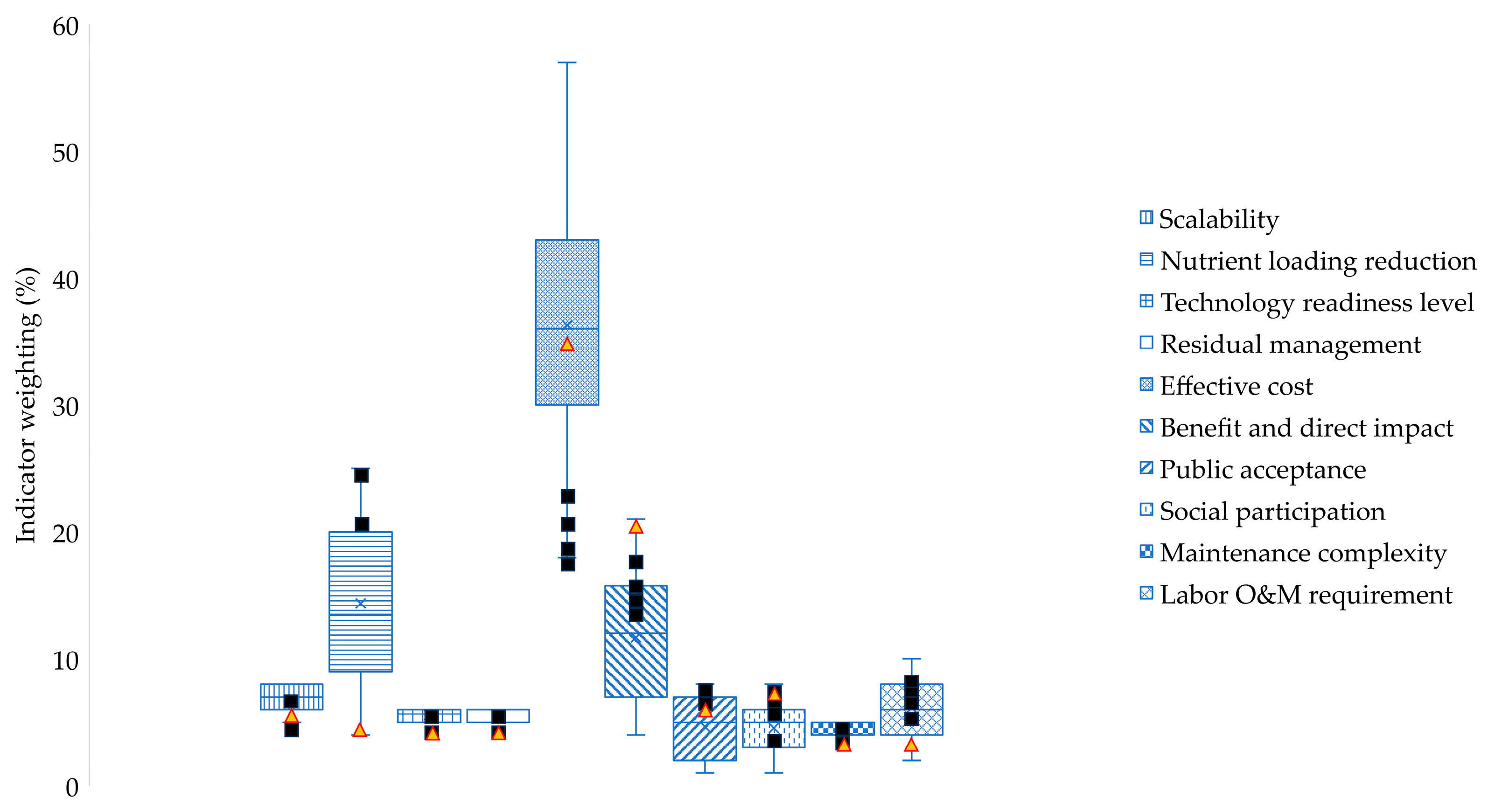
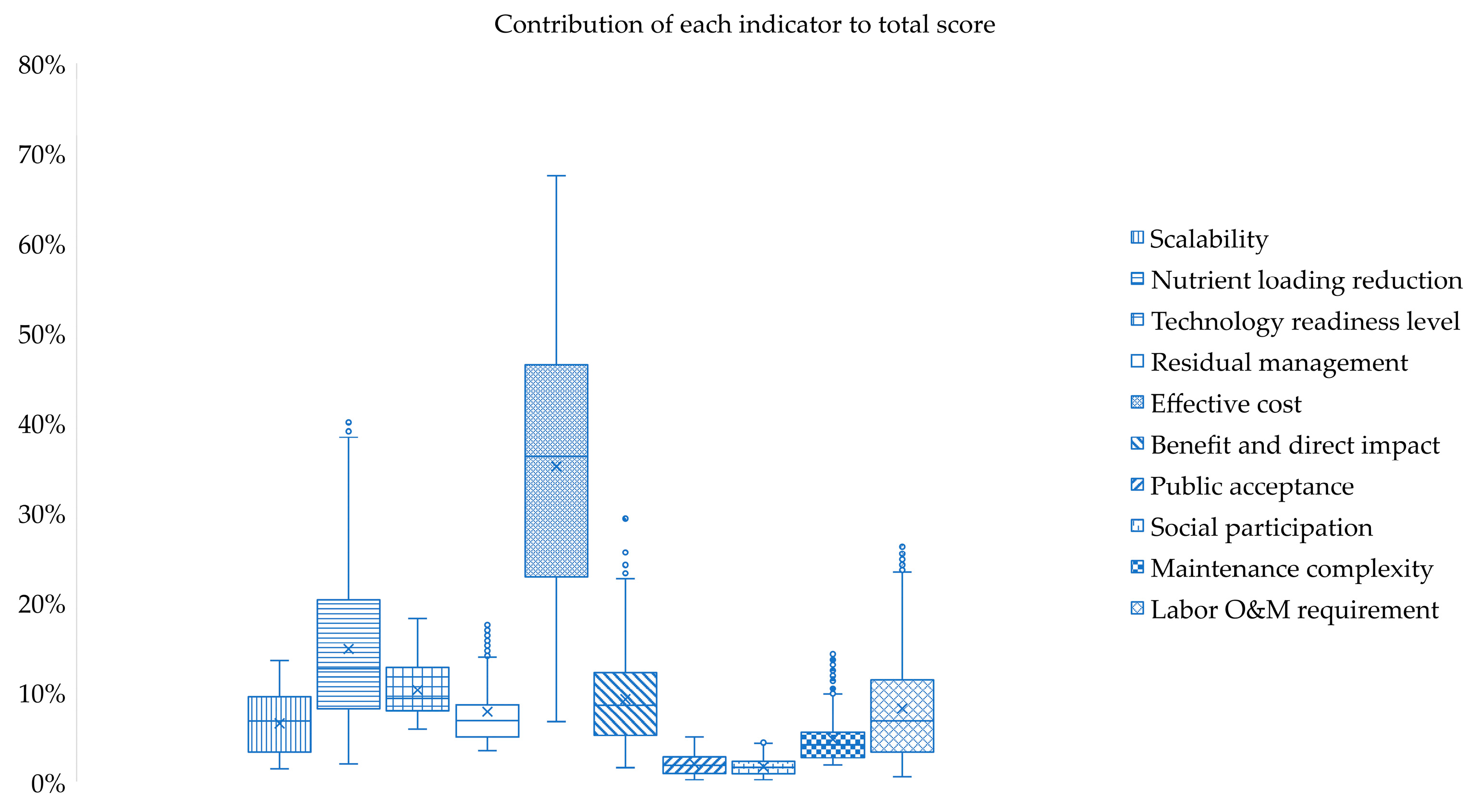
| Developed Framework. | SFWMD Framework | ||
|---|---|---|---|
| Indicator | Weighting | Indicator | Weighting |
| Scalability | 5 to 8.33% | Scalable | 5 |
| Nutrient loading reduction | 3.57 to 25% | Confidence in performance estimates | 5 |
| Technology readiness level | 5 to 6.67% | Available Florida case study | 4 |
| Residual management | 5 to 6.67% | Residual production | 4 |
| Benefit and direct impact | 4 to 21.53% | Habitat | 3 |
| Labor O&M requirement | 2 to 10% | Ecosystem services | 2 |
| Maintenance complexity | 3.33 to 5% | Energy efficiency | 2 |
| Public acceptance | 1 to 8.81% | Land requirements | 2 |
| Social participation | 1 to 8.81% | O&M | 2 |
| Effective cost | 5 to 50% | Schedule of implementation | 1 |
| Cost-effectiveness | 30 | ||
| Sum | 100% | Sum | 60 |
Disclaimer/Publisher’s Note: The statements, opinions and data contained in all publications are solely those of the individual author(s) and contributor(s) and not of MDPI and/or the editor(s). MDPI and/or the editor(s) disclaim responsibility for any injury to people or property resulting from any ideas, methods, instructions or products referred to in the content. |
© 2024 by the authors. Licensee MDPI, Basel, Switzerland. This article is an open access article distributed under the terms and conditions of the Creative Commons Attribution (CC BY) license (https://creativecommons.org/licenses/by/4.0/).
Share and Cite
Hua, J.; Cooper, R.Z.; Cornejo, P.K.; Ergas, S.J.; Zhang, Q. A Holistic Sustainability Assessment Framework for Evaluating Strategies to Prevent Nutrient Pollution. Sustainability 2024, 16, 5199. https://doi.org/10.3390/su16125199
Hua J, Cooper RZ, Cornejo PK, Ergas SJ, Zhang Q. A Holistic Sustainability Assessment Framework for Evaluating Strategies to Prevent Nutrient Pollution. Sustainability. 2024; 16(12):5199. https://doi.org/10.3390/su16125199
Chicago/Turabian StyleHua, Jiayi, Rachael Z. Cooper, Pablo K. Cornejo, Sarina J. Ergas, and Qiong Zhang. 2024. "A Holistic Sustainability Assessment Framework for Evaluating Strategies to Prevent Nutrient Pollution" Sustainability 16, no. 12: 5199. https://doi.org/10.3390/su16125199





